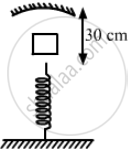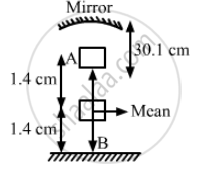Advertisements
Advertisements
प्रश्न
A mass m = 50 g is dropped on a vertical spring of spring constant 500 N m−1 from a height h = 10 cm as shown in figure. The mass sticks to the spring and executes simple harmonic oscillations after that. A concave mirror of focal length 12 cm facing the mass is fixed with its principal axis coinciding with the line of motion of the mass, its pole being at a distance of 30 cm from the free end of the spring. Find the length in which the image of the mass oscillates.
उत्तर
Given,
Mass = 50 g
Spring constant, k = 500 Nm−1
Height from where the mass is dropped on the spring, h = 10 cm
Focal length of concave mirror, f = 12 cm
Distance between the pole and the free end of the spring is 30 cm.
As per the question, when the mass is released it will stick to the spring and execute SHM.
At equilibrium position, weight of the mass is equal to force applied by the spring.
∴ mg = kx
where g is acceleration due to gravity
`⇒ X = mg / k `
`= 50 xx 10^-3 xx 10 / 500`
`= 10^-3m = 0.1 cm`
Therefore, the mean position of the SHM is (30 + 0.1 = 30.1) cm away from the pole of the mirror.
From the work energy principle,
final kinetic energy − initial kinetic energy = work done
⇒ 0 − 0 = mg(h + δ) − `1/2 Kδ^2`
Where δ is the maximum compression of the spring.
mg(h + δ) = `1/2Kδ^2`
⇒ `50 xx 10^-3 xx 10 ( 0.1 + δ ) = 1/2 500δ^2`
`δ = 0.015 m = 1.5 cm 
From the above figure,
Position of point B, (30 + 1.5) = 31.5 cm from the pole of the mirror
Therefore, amplitude of vibration of SHM, (31.5 − 30.1) = 1.4 cm
Position of point A from the pole of the mirror, (30.1 − 30.1) = 28.7 cm
For point A,
Object distance (ua) = − 31.5
f = − 12 cm
By using the lens formula:
` 1/(va) - 1/(ua) = 1/f`
`⇒ 1/(vb) = 1/f + 1/(ub)`
`= 1/(-12) + 1/(-28.7)`
`= vb = -20.62 cm`
Hence, the image of the mass oscillates in length (20.62 − 19.38) = 1.24 cm
APPEARS IN
संबंधित प्रश्न
An object is placed 15 cm in front of a convex lens of focal length 10 cm. Find the nature and position of the image formed. Where should a concave mirror of radius of curvature 20 cm be placed so that the final image is formed at the position of the object itself?
A mobile phone lies along the principal axis of a concave mirror. Show, with the help of a suitable diagram, the formation of its image. Explain why magnification is not uniform.
Suppose the lower half of the concave mirror's reflecting surface is covered with an opaque material. What effect this will have on the image of the object? Explain
A convex lens of focal length 20 cm is placed coaxially with a concave mirror of focal length 10 cm at a distance of 50 cm apart from each other. A beam of light coming parallel to the principal axis is incident on the convex lens. Find the position of the final image formed by this combination. Draw the ray diagram showing the formation of the image
A convex lens of focal length 20 cm is placed coaxially with a convex mirror of radius of curvature 20 cm. The two are kept 15 cm apart. A point object is placed 40 cm in front of the convex lens. Find the position of the image formed by this combination. Draw the ray diagram showing the image formation.
Draw a ray diagram to show image formation when the concave mirror produces a real, inverted and magnified image of the object.
Obtain the mirror formula and write the expression for the linear magnification.
A convex lens of focal length 20 cm is placed coaxially in contact with a concave lens of focal length 25 cm. Determine the power of the combination. Will the system be converging or diverging in nature?
A convex lens of focal length 25 cm is placed coaxially in contact with a concave lens of focal length 20 cm. Determine the power of the combination. Will the system be converging or diverging in nature?
A convex lens of focal length 30 cm is placed coaxially in contact with a concave lens of focal length 40 cm. Determine the power of the combination. Will the system be converging or diverging in nature?
A convex lens of focal length f1 is kept in contact with a concave lens of focal length f2. Find the focal length of the combination.
Use Huygens’ geometrical construction to show the behavior of a plane wavefront.
(i) Passing through a biconvex lens;
(ii) Reflecting by a concave mirror
A concave mirror of radius R is kept on a horizontal table (See figure). Water (refractive index = μ) is poured into it up to a height h. Where should an object be placed so that its image is formed on itself?

A hemispherical portion of the surface of a solid glass sphere (μ = 1.5) of radius r is silvered to make the inner side reflecting. An object is placed on the axis of the hemisphere at a distance 3r from the centre of the sphere. The light from the object is refracted at the unsilvered part, then reflected from the silvered part and again refracted at the unsilvered part. Locate the final image formed.
The convex surface of a thin concavo-convex lens of glass of refractive index 1.5 has a radius of curvature 20 cm. The concave surface has a radius of curvature 60 cm. The convex side is silvered and placed on a horizontal surface as shown in figure. (a) Where should a pin be placed on the axis so that its image is formed at the same place? (b) If the concave part is filled with water (μ = 4/3), find the distance through which the pin should be moved so that the image of the pin again coincides with the pin.

A small block of mass m and a concave mirror of radius R fitted with a stand lie on a smooth horizontal table with a separation d between them. The mirror together with its stand has a mass m. The block is pushed at t = 0 towards the mirror so that it starts moving towards the mirror at a constant speed V and collides with it. The collision is perfectly elastic. Find the velocity of the image (a) at a time t < d/V, (b) at a time t > d/V.
A gun of mass M fires a bullet of mass m with a horizontal speed V. The gun is fitted with a concave mirror of focal length f facing towards the receding bullet. Find the speed of separation of the bullet and the image just after the gun was fired.
